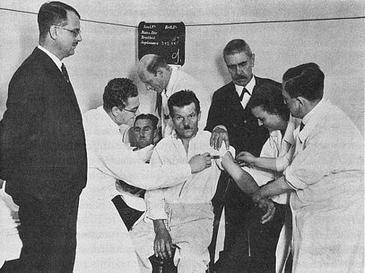
Some points of interest related to the Biological Treatments portion of my Abnormal Psychology course:
1. Here is the link to my piece on Electroconvulsive Therapy from Feb. 2013. Be sure to watch Mary, before and after.
2. And here is a blogpost about lobotomy from May 2013. It contains a link to a full length documentary on Walter Freeman. Here is a short version (trailer) of The Lobotomist documentary:
3. Here's an excerpt from a book review from the journal of the Minnesota Medical Association that discusses both Henry Cotton (focal infection theory) and Walter Freeman:
To the Trenton State Hospital in 1907 came psychiatrist Henry Cotton, who had been trained by Adolf Meyer, M.D., the godfather of American psychiatry at the time. Meyer had fostered a culture of actively treating the mentally ill at Worcester State Hospital in Massachusetts. Dubbing Freud as a “fraud” and comparing psychoanalysis to Christian Science, Cotton found the state hospital in “deplorable condition,” with guards wielding unchecked violence and brutality on patients. Cotton dispensed with most restraints and taught attending physicians that they should not just write off patients as “crazy.”
Cotton assumed his post at Trenton just as medicine was emerging from a flurry of discoveries in infectious disease with the identification of organisms causing typhoid, cholera, tuberculosis, malaria, and diphtheria. Suddenly, it seemed as though all human disease was caused by infection and “the practical payoffs of the bacteriological revolution seemed limitless.” Quickly, the bacterial paradigm spread to all areas of medicine. At Chicago’s Rush Medical College, Frank Billings, M.D., trumpeted the “etiological relationship of focal infection to systematic diseases” and created the Memorial Institute for Infectious Disease and the Sprague Memorial Institute at St. Luke’s Free Hospital. Edward Rosenow, M.D., brought the theory of focal infection and systemic illness to Mayo Clinic, and a new concept of “surgical bacteriology” suggested that “chronic intestinal stasis … flooding the circulation with filthy material” caused autointoxication. Cure required surgically removing the infection.
Cotton applied the theory of focal infection to the illnesses of his Trenton patients, stating that psychosis was a “symptom … of long continued chronic sepsis,” and started attempting to surgically rid them of infection. He found rampant dental infection and removed so many teeth that Trenton was dubbed the “Mecca of exodontias.” Tonsils were excised, gallbladders removed, and parts of or entire colons resected. The proof of infection in the offending organs was slim even by early 20th century standards. The toll of lives lost was staggering with mortality rates for colectomy approaching 50 percent. And the documentation of resolved psychiatric illness was paltry.4. Here is an excerpt from the Nobel Prize website, which defends the award given to Egas Moniz, developer of the prefrontal lobotomoy:
A survey of all patients who underwent leukotomy in England and Wales from 1942 to 1954 (Tooth et al 1961) documented 10,365 single leukotomy operations. An additional 762 patients underwent more than one operation. A follow-up study covering 9,284 of the above mentioned patients showed that 41% had recovered or were greatly improved while 28% were minimally improved, 25% showed no change, 2% had become worse and 4% had died. Not surprisingly, patients with an affective disorder showed the best prognosis with 63% recovered compared to 30% among schizophrenic patients.
In the United States approximately 10,000 operations had been performed by August 1949. After 1954 the number of operations steadily decreased. As there were no alternative therapies for severe mental disorders, psychoses in the 1930s, it is not surprising that lobotomy was quickly accepted as a therapy for chronic schizophrenic psychoses, even if it seems a bit strange that lobotomy initially was tried with affective disorders. Lobotomy is an ethically dubious treatment if carried out against the patient´s wishes, but this is always a difficult question in severely psychotic patients who totally lack insight about their illness - what is it exactly that such a patient wants? Historically, it is easy to understand that psychosurgery was considered as a therapeutic advance. Today, it is easy to hold a negative opinion about the use of lobotomy and consider it very strange that Moniz was awarded the Nobel Prize. However, I agree with Swayze (1995) who has written: "If we learn nothing else from that era, it should be recognized that more rigorous, prospective long-term studies of psychiatric outcome are essential to assess the long-term outcomes of our treatment methods."
5. 1934 photograph shows Julius Wagner-Jauregg present at the transfusion of blood from a malaria patient to a patient who suffers from neurosyphilis, in order to trigger fever that will kill the spirochaetes. This approach, for which Wagner-Jauregg won the 1927 Nobel Prize in Physiology, is a type of Pyrotherapy.
6. Here is the Wikipedia page of James W. Watts, who assisted Walter Freeman and who graduated from VMI sometimes in the early 1920s.
Walter Freeman is pointing to the X-ray; James Watts is next to him.


No comments:
Post a Comment
Note: Only a member of this blog may post a comment.